When photographing, along with the settings excerpts, aperture, ISO and image quality, one of the most important parameters for a SLR camera is the correct setting of the focus mode and method.

Focus on Nikon
Nikon has many focus options with different combinations of focus modes and focus areas. Usually focusing on modern Nikon DSLR cameras occurs when pressing the shutter button halfwayor by pressing the dedicated AF-ON button.
Focus Modes:
'AF-S' or 'S' (Auto Focus Single) - focus mode camera, in which the camera, when the shutter button is pressed halfway, focuses on focus, and when a successful aim is achieved, it stops focusing. Once pressed - once focused... In the manuals for cameras, the mode is often translated as'Single AF Tracking'. To change the aiming accuracy, release the button and press it again. The mode is suitable for static scenes.
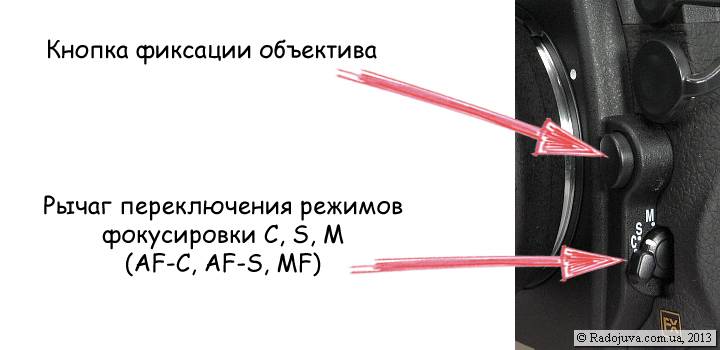
Focus mode switch Nikon D700. The same is available on cameras Nikon D300, D300s, D200, D1, D2, D3 etc.
'AF-C' or 'C' (Auto Focus Continuous) - tracking continuous (continuous) mode of automatic focus of the camera (in the instructions it is often translated as'Continuous AF Tracking'). When the shutter button is pressed halfway, the camera constantly tries to focus correctly. Pressed the button - and the camera constantly monitors the focus. A very useful mode when subjects are moving or composition changes.
AF-A (Auto Focus Automatic) - automatic focus mode selection camera. In this mode, the camera can choose to work in AF-S or AF-C mode. Basically, all amateurs shoot in AF-A mode and often do not even suspect the presence of other modes. I noticed that the mode AF-A more often behaves like the AF-S mode.
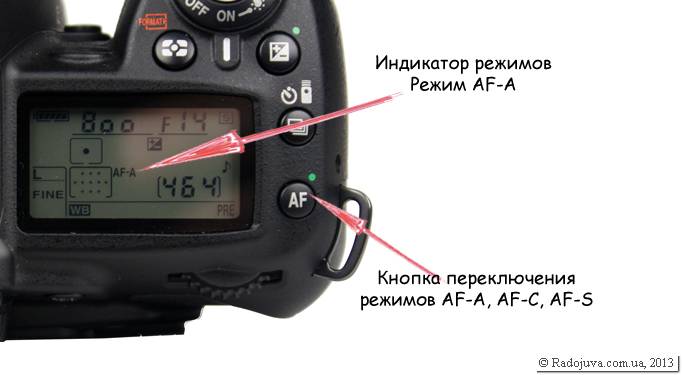
AF-A, AF-C, AF-S mode selector on Nikon D90
AF (auto focus) - general auto focus mode. The mode is enabled on the camera itself, not to be confused with the 'A' mode on the lens itself.
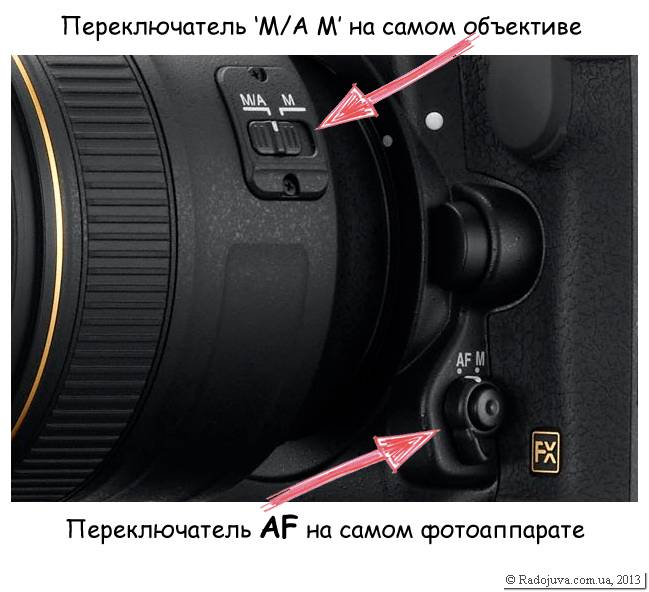
AF focus mode switch (lever) on the camera
MF (manual focusing) - manual focus camera... The mode is activated using the camera menu. Usually only cameras without a focus motor have this mode. In this mode, you need to manually rotate the focusing ring on the lens to achieve correct focusing. On the one hand: manual focus can be difficult for beginners, on the other hand: it is A vital focus method for advanced photographers and professionals. Manual focus on the CZK is one of the major advantages over conventional digital cameras (soap dishes). Very often, the automation of the camera and the lens cannot determine how to focus correctly and to achieve optimal focus, just switch to manual mode and point the camera manually for precise focus.
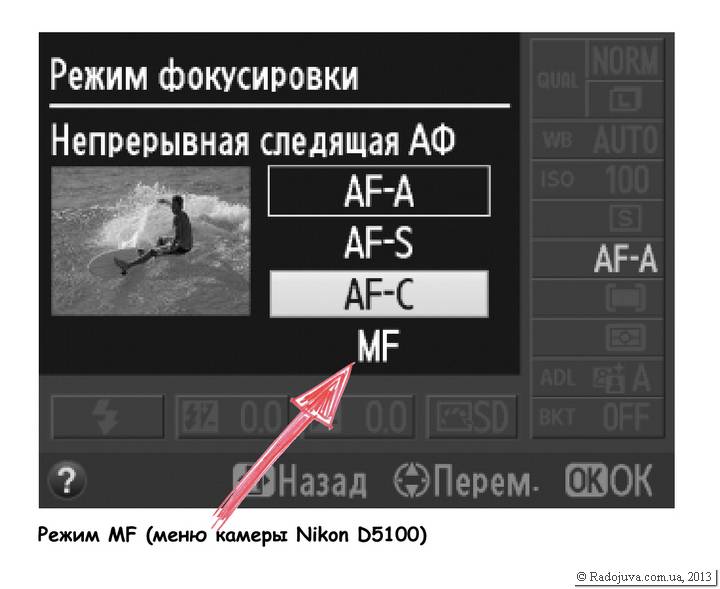
Focus Mode Switch Using the Nikon D5100 Camera Menu
M (M - manual focusing) - manual focus on the lens or on the camera. Same as MF. Attention: Not all lenses have a focus mode switch, such as a lens Nikon 50mm f / 1.8D AF Nikkor It has no focus switches at all. It's important: in order to switch to manual focus mode MF with a lens that does not have a focus mode switch, you need to switch the focus lever to mode M on a camera with a focus motor; on a camera without a focus motor, only the MF mode with such a lens will always be available. About different types of lenses and cameras is described in detail in the section Nikon Lens Differences.
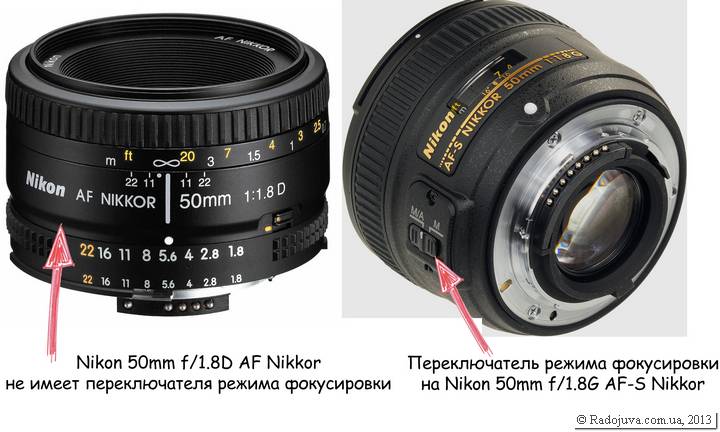
Lens with focus mode switch and lens without focus mode switch
A (Auto) - auto focus mode lens. In this position of the focus switch on the lens, only automatic focusing with the lens is available. Attention: not all lenses have such a focus operation switch, for example, the switch on the lens is shown below Nikon 85mm f / 1.4D AF Nikkor.
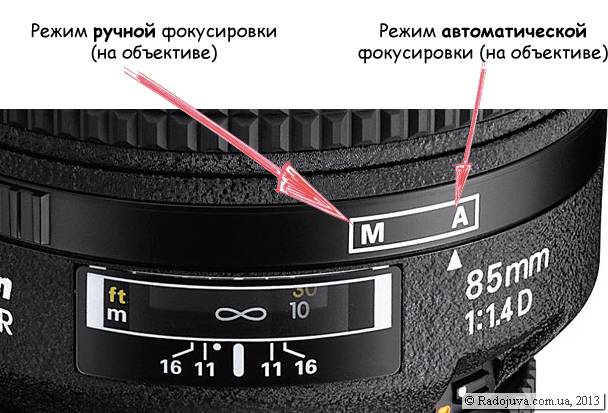
Example of a manual or auto focus lens
M / A (autofocus with manual override) - automatic focusing lens with priority of manual control. Attention: not all lenses have this focus mode, the example below shows the switch on the lens Nikon 85mm f / 1.4GN AF-S Nikkor. This mode implies auto focus with instant manual focus adjustmentand the lens does not need to be set to focus mode 'M'. You can read more about this mode. here.
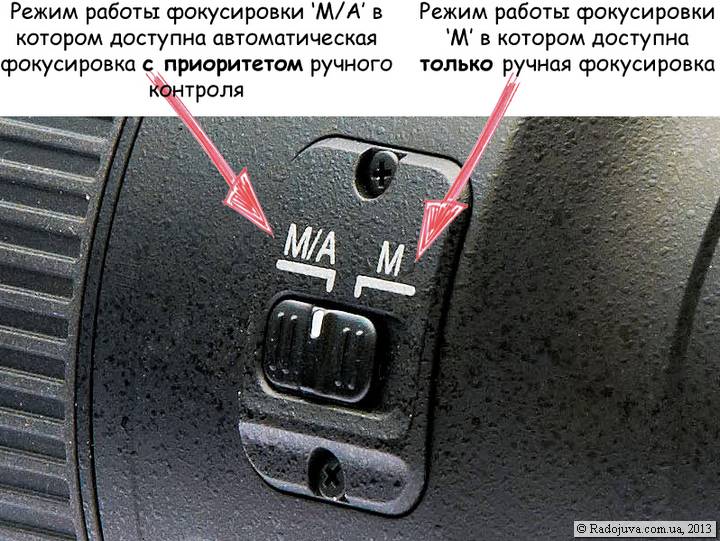
This is how the switch of focus modes on the lens with support for MA-M mode looks
AF-F (Full Time Servo Auto Focus) - continuous tracking focus mode for video shooting. Attention: This focus mode is only available on modern cameras with the ability to record video. This mode does not work when taking pictures. Usually you cannot find the mode in the menu AF-F, it is only available in live view when entering the info menu. This is a very useful mode, it allows you to record with constant auto focus. This mode is available only in cameras starting from Nikon D3100.
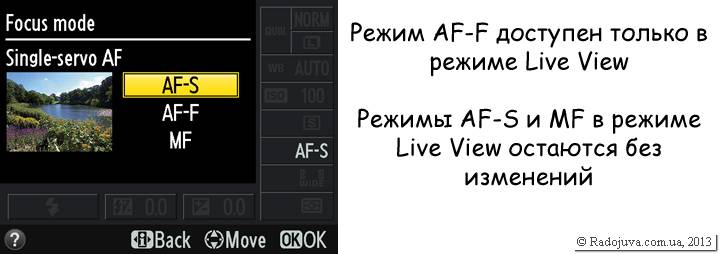
AF-F mode for shooting video
Important: due to the fact that all Nikon CZKs have different controls and different menus, each camera switches its focus mode in its own way. In the general case, M, AF, S, C is responsible for choosing the focus mode switch near lens mount for cameras with a focus motor and settings in the menu of the camera itself. For non-powered cameras, the focus mode is selected only through the camera menu. Different combinations of settings for different types of cameras are shown in the diagrams above.
Damn important: if you use a camera with a focus motor, and on it is a lens with auto focus but without a focus motor and without a focus mode switch on the lens itself, for example, a bunch Nikon D90 (camera with motor) and lens Nikon 85mm f / 1.8D AF Nikkor (without focusing motor and without focusing mode switch) - for manual focusing, be sure to switch the lever near the camera mount to the 'M' position, otherwise when focusing manually can damage the camera.
A number of cameras from Nikon have a built-in rangefinder (focus indicator in the viewfinder). The rangefinder in the viewfinder can tell in which direction you need to rotate the focus ring on the lens in order to achieve the correct focus. The range finder works both with automatic and manual focusing. Rangefinder is in the cameras Nikon D3100, D5100, D700 etc. In general, on older lenses that could not focus automatically, there is a special focusing scale, which indicates the distance to the focusing object. It's a pity when using the old AI-S optics on younger Nikon cameras, the rangefinder refuses to work. With manual optics, the rangefinder only works on older Nikon cameras.
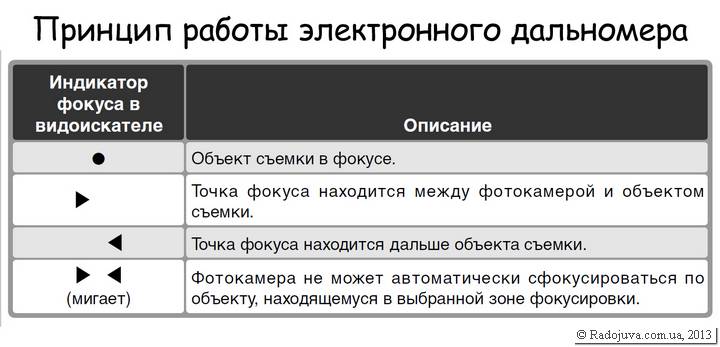
The principle of operation of the electronic rangefinder
On any Nikon CLC camera, the green circle in the viewfinder in the lower left corner of the viewfinder is responsible for the accuracy of focusing on the selected focus point. When it is on, this means that the sharpness at the selected point is normal. The green dot (focus confirmation point) is an indispensable tool when working with old class lenses AI-S and similar, for example, such as Nikon 100mm F / 2.8 Series E MF
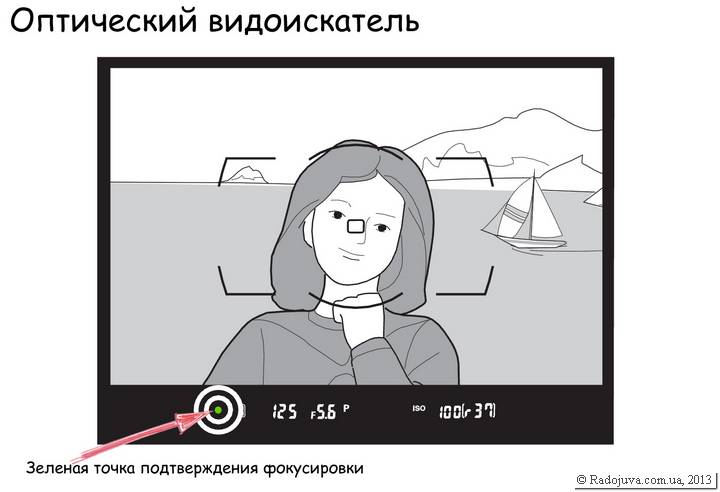
A green dot that confirms correct focus
Advanced cameras have fine-tuning the focus: Release priority and Focus priority in AF-C and AF-S mode.
Usually in AF-C mode, the choice is:
- FPS frequency - the shutter release is more important for the camera than the focusing accuracy, this is called release priority
- FPS + AF frequency - the shutter is more important for the camera, but it also takes into account the focusing accuracy (not available on all cameras)
- Focus - the focus is more important for the camera, not the shooting speed.
Using the priority setting, you can set what is most important when shooting - focus, and then release the shutter, or release the shutter and ignore focus. I set AF-S priority to focus priority mode, AF-C to shutter priority mode.

Setting Focus Priorities
Important Note:
Younger Nikon cameras do not support shutter priority mode (release priority). The exact list of cameras, as well as other useful information on limiting priorities, can be found in the section “Unpleasant restriction of Nikon entry-level cameras and its solution", As well as in the section"Restructuring AF-S, AF-C modes when working with an external flash. Features Focus Focus".
Live View
live view allows you to turn a complex SLR camera into an ordinary soap box, that is, you can focus (photograph) using the large display of the camera itself, and not through the optical viewfinder (peephole). In Live View, focus is based on contrast. This method is much slower for normal focusing through the optical viewfinder. Moreover, the difference in focusing speed in Live View mode and through the optical viewfinder can be tens of times. Some cameras have two focusing modes in Live View mode. The first one is “tripod” focusing, it is done as on conventional digital cameras (dichotomously, in contrast). Second, you can frame the frame through Live View, but when you press the shutter button to focus, the camera turns off Live View, focuses through the usual focusing system, and then turns on Live View again or takes a picture. For a simple description of how Live View works, see Dmitry Evtifeev’s blog.

How Live View Works
Important:
camera Nikon D700 и Nikon D300 in Live View and Tripod sub-modes, focus only when AF-ON button is pressed.
Focus Points and Focus Areas
Each camera has a different number of points and areas through which it can focus. A special module is responsible for focusing in the camera, which is located at the bottom of the camera’s mirror. The focusing module just calculates the phase values, on the basis of which it gives a command to perform focusing. In fact, modern central control valves have two mirrors, the second mirror serves to perform focusing through the focus module, in more detail here... Usually, a focusing module consists of a certain number of points (zones) on which focus analysis is performed. For 2012 Nikon has cameras with 3, 5, 11, 39, 51 focus points. The number of points affects the usability and focusing accuracy of the camera. You can read in more detail about focus systems on Nikon cameras.
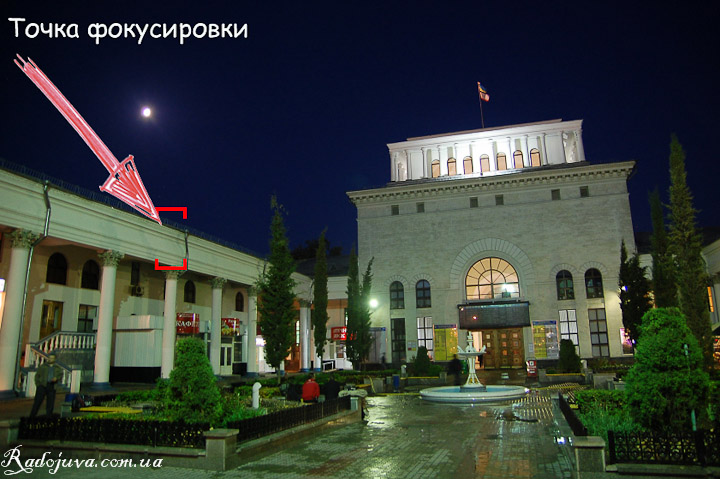
The image shows the focus point where focus is achieved.
For working with focus points, the settings are responsible. AF-area mode.
- Automatic (auto-area AF), denoted as a white rectangle. Focuses on the closest subject using all available points.
- Dynamic (dynamic-area AF), focusing works on only one point, but takes into account information with adjacent points
- Single Point AF, focuses on only one point.
- Additional: 3D-tracking, or the choice of several zones. Such settings are not available on all cameras and often they are sub-functions of the dynamic focus area selection.
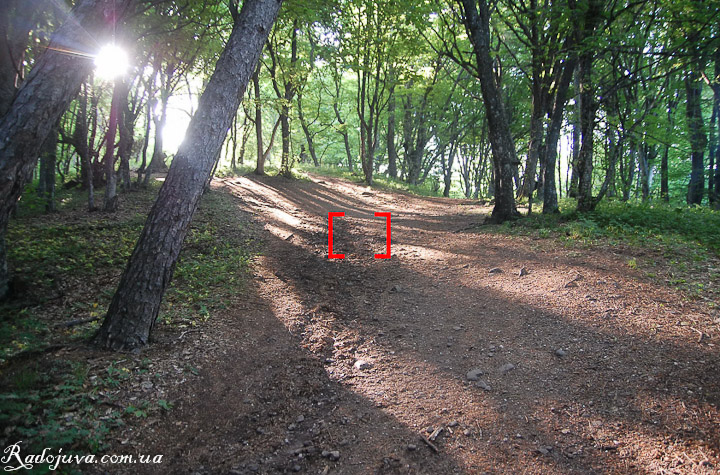
Points and focus method: AF-S single point
Important:
It’s very convenient to set the choice of the focus area method for amateur and advanced amateur cameras using a soft key (as I did on Nikon D90) This will allow you to quickly switch between focusing on a single point, automatic zone selection, dynamic mode, 3D tracking, etc. On Nikon professional and flagship cameras, a special zone switch is provided, which simplifies the work with professional equipment.
Attention:
in manual focus mode (M, MF), only one focus point is available.
Important:
A number of cameras can show in the image at which point or group of points the focus was performed. When viewing a picture, you can activate a mode in which the focus points are indicated by squares. This mode is supported only by professional cameras of the type D200, D300 and all full-frame. This is convenient because when setting up a quick preview of the image on a 1 to 1 scale, scaling is done exactly at the focus point at which the shooting was performed. This allows you to quickly check and select good sharp pictures. On advanced amateur and amateur cameras, to view the correct focusing, press the zoom button, and then use the selector to find the area in the image by which focus was performed. If your camera does not have a function that shows at which point the focus was performed, you can use ViewNX, which comes with the camera. Focus points can be displayed on the computer display. This is sometimes very helpful. In the sample photos, I just copied the work of ViewNX 2.
Important:
ViewNX only displays focus points on the computer when the picture was taken in AF-A, AF-S, AF-C modes with focus priority. If AF-S, AF-C with shutter priority is selected, the program will show focus points only if the camera was sure that the focus was correct.
Important:
Not all Nikon cameras allow you to change the area and type of focus when using the automatic modes (green mode). In modes P, A, S, M, everything can be customized to your taste.
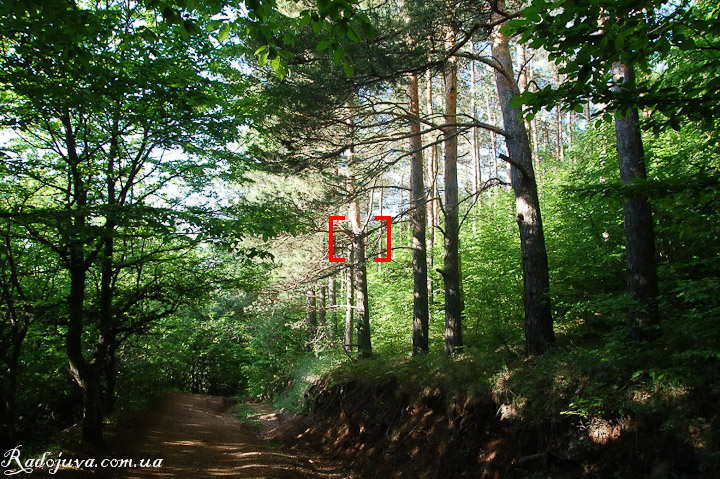
Single point focus. AF-C focus mode
Focus point loop function
This function simply allows you to move the focus point in a circle, thus looping it around. When the rightmost point is selected, when you press the selector right, the focus point will go to the leftmost position. This function simply allows you to speed up the work when focusing on a single point.
Wide and standard focus area
In some cameras, you can choose a wide focus area, in contrast to the usual. A wide focus area reduces the number of focus points (zones). For example, for Nikon D200 With 11 focus points, 7 wide areas are created. Optically in the viewfinder, the zones will be larger in size than the dots. This sometimes simplifies the work with the camera.
Focus adjustment (alignment)
Sometimes the lens may malfunction and focus behind the subject (back) or in front of the focus object (front). In the people, such a lack of lenses is called back focus, front focus (back and front focus). Some cameras may adjust to the “wrong” lens. To do this, you need to find the focus adjustment in the camera and adjust the focus. Only have tuning Nikon D300, D300s, D500, D7000, D7100, D7200, D7500, D700, D750, D780, D800e, D800E, D810,D810a, D3, D3s, D3x, D4, D4s, D5, Df, D600, D610.
Focusing with Dark Lenses
Almost all Nikon cameras can focus without problems automatically only when using lenses with apertures up to F / 5.6. This is indicated in the camera manual. When using lenses with a smaller aperture, such as the Tamron 28-300mm F / 3.5-6.3 XR Di VC LD Asph (IF) Macro, it may be difficult to focus on the F / 6.3 aperture. Also, when using teleconvertersthat decrease the effective aperture value of the converter lens, focusing problems may also occur. Only a few cameras can focus without problems with F / 8.0 lenses. The limitation is related to the number of focus points that can work normally at F / 5.6-F / 8.0. You can find more details about which cameras and which focus points (zones) are used to work with 'dark' lenses here.
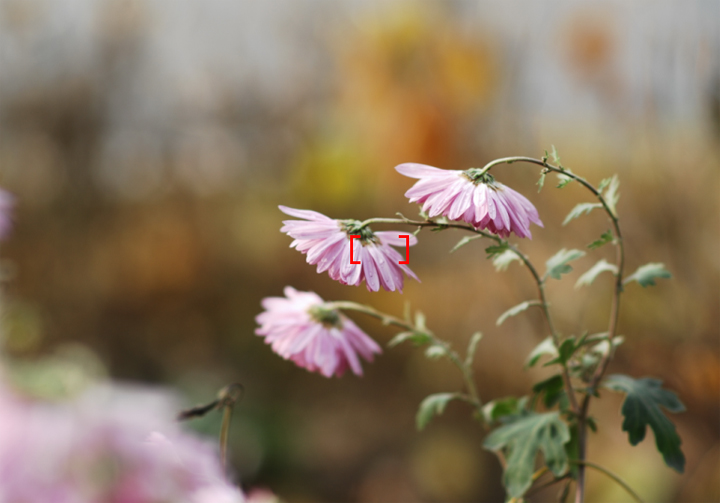
Single-point focusing with the Nikon D2Xs
Cross-shaped focus points (sensors) vs regular focus points
How many times I didn’t use one-point focusing, I did not find the difference in the quality of focusing using the cross-shaped point and the usual focusing point. Basically, cross-shaped focus points (sensors) are said to do a much better job of focusing than regular focus points. It is generally accepted that cross-shaped focus points are better at handling 'wire against sky' scenes.
Focus light
Nikon cameras have a special light bulb that helps focus in dark conditions. The light bulb simply illuminates the subject in focus and autofocus is easier to focus on. The backlight may not come on in AF-C mode. The focus light is often called the “spotlight” and is recommended to be turned off. Personally, I have the backlight turned off, but in poor lighting conditions I use a flash that has its own "red spot" with a long range. More details about the flashlight in photo tricks section.
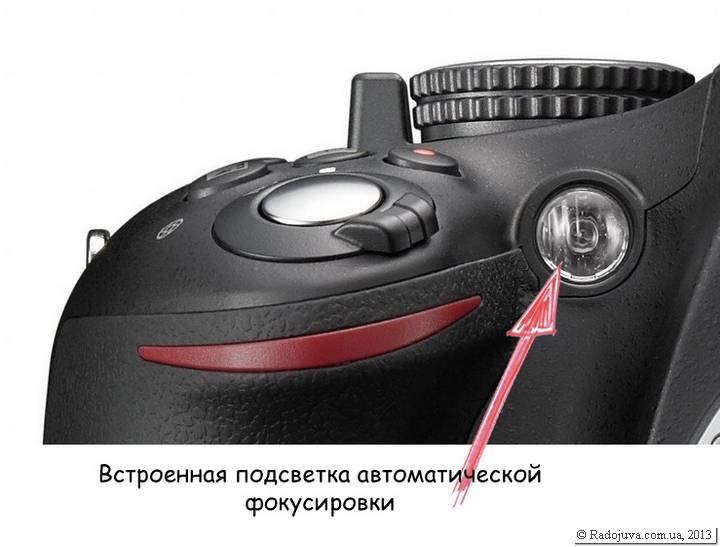
Focus light
Important:
Some Nikon CLCs for some reason do not illuminate the subject with the AF-assist lamp in single-point focus mode, if a non-central point is selected. As far as I know, all Nikon cameras provide auxiliary illumination with a lamp in single-point focus mode, if the center focus point is selected.
Important:
Flagship Niko camerasn such as Nikon D1, Dh, D1x, D2h, D2x, D2hs, D2xs, D3, D3s, D3x, Df, D4, D4s, D5 do not have a focus assist lamp at all.
Interesting:
Nikon cameras can be implemented very simply focus trap.
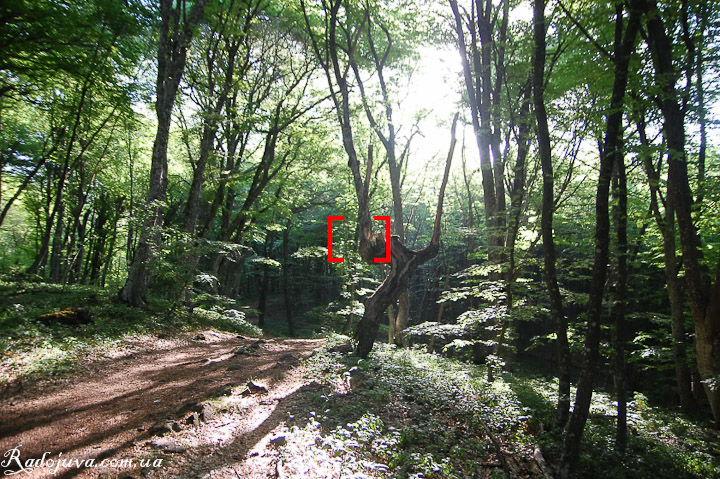
AF-S single-point focusing mode
My experience and recommendations on focusing on Nikon cameras can be found here.
Is everything complicated and little understood?
Then just turn on AF-A and the icon with a rectangular focus area. Automation copes well with the main tasks. I recommend fully automatic focusing for home use. Sometimes fine-tuning the modes of the focus points does not justify itself.
Which Nikon camera focuses best?
Focus best Nikon D5 and Nikon D500 with the most advanced focus modules.
Comments on this post do not require registration. Anyone can leave a comment. Many different photographic equipment can be found on AliExpress.
Conclusions:
Learning how to deal with focus modes will help you more accurately and quickly achieve the desired result. I strongly recommend experimenting with the modes and focus areas on your camera.
Material prepared Arkady Shapoval. Training/Consultations | Youtube | Facebook | Instagram | Twitter | Telegram

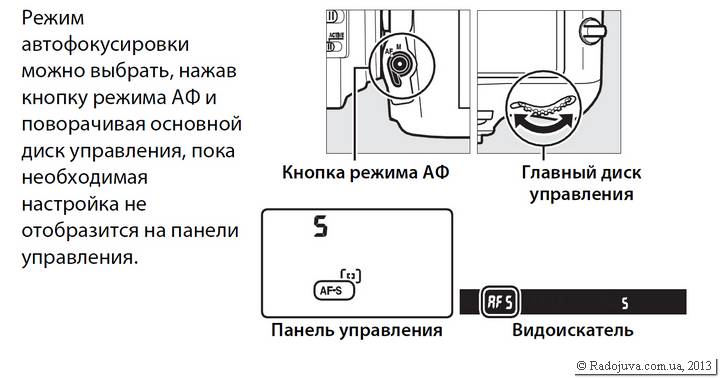

Photo one is similar to the railway station of Simferopol!)
This is it.
It is worth noting in the article (for beginners and lazy ala - “the instruction to read is not a royal occupation” it will not be obvious) that it is impossible to turn on the auto focus mode on cameras with a D50 / D70 / D80 / D90 / D200 / D300 / D7000 / D700 / D3 screwdriver, and on the lens manual. It will turn out like this: the camera will try to twist the focus, and the lens will not allow it to be done as it should, so there is a chance, albeit a little, to damage the auto focus control mechanism in the camera. Always ... no not, ALWAYS turn on the manual mode (M / A) on the CAMERA first and only then disassemble the lens. The same applies to the installation of unknown lenses, if you are not sure how to correctly turn on the manual mode on the camera, so at least you will not break anything.
I forgot to add that all this concerns the bundle: Camera with a motor - Lens without a motor.
Here you are wrong. For example, if you take a lens of this kind - https://radojuva.com.ua/2012/11/obzor-nikon-85-mm-1-4-d/ and set the manual focusing mode M on the lens (thus disabling automatic focusing), and leave the automatic mode on the camera - the focusing motor in the camera will not work.
Arkady, tell me! The device is Nikon D90. I set the focus in the center, and the point is lower. Am I doing something wrong or is this a camera malfunction?
Most likely, you are doing something wrong.
Everything! Understood, it was in the settings!
people read the instructions there everything is written
Arkady, hello.
Thank you so much for your articles, I can not tear myself away, addictive.
Tell me, how is it nevertheless more accurate to perform focusing when cropping: using continuous tracking autofocus in AF-C mode + choosing a zone with 3D tracking, or one point at a time with moving to the desired part of the frame in AF-S mode?
Here I read above in the comments that when cropping in AF-C, the influenza changes. What is it like? I understand this: when cropping to the right, left, or up and down, the focus point remains on the subject, but moves to the desired portion of the frame in the viewfinder. Because the camera focuses continuously in AF-C mode, the focal plane should also be fixed on our subject in the right place on the frame. Does the influenza change at the same time? I think in this case, the FLU will change if you take a step forward or backward.
There is something confused about the IPIG. In different shooting conditions, focusing on one point or on one point with 3D tracking will have different priorities.
It is clear that the choice of one mode or another will be a priority, depending on the scene being shot. What do you think, specifically for cropping (static scenes), which focus method will be more correct or more accurate: AF-S with the choice of the desired point, or AF-C with tracking?
AF-S on a point would be better.
Arkady, I also had a problem focusing on the D7000. I bought a 50mm 1.8 glass and I see that it smears with focus. I shot it at the target and found out that there is a good back focus. Adjusted to -20 but the back focus remained a little more. On glasses 18-105 there is also a small back, on Tamron 70-300 VC USD - -9
I think that the matter is in the carcass, since all the glasses give me back focus.
Is it possible to adjust focus without SC?
On the Internet, I met a manual for self-adjustment using the bolts for adjusting the camera mirror - but there are a million subtleties, it is better to take it to the service.
Hello, Arkady, please tell me which lens is better to get on China 18-55. . .! I don’t want a lot of interchangeable lenses, I'm not a professional photographer, I just want to have one good universal lens, which is suitable for photographing a moving child indoors, in an apartment and on the street, and for taking pictures of nature, landscapes, for example, if traveling, and for memorable events (wedding, christening, etc.).
Olga has only one answer - Nikkor 24-70 f2,8 - very fast focusing (for mobile kids this is the best) ... For weddings, christenings, etc. - 99% of the shooting day will be enough for sure.
Dear, have you seen the price of 24-70? 14588 UAH at the outlet! Do not scare people. Tamron 17-50 or 28-75, here is the normal option. And the price is sane and aperture, only what sort of focal is more suitable. On Radozhiv there are, by the way, excellent reviews of the above lenses
Of course, if a rich person costs 100 thousand rubles and which one is 160
Good day ! Tell me, I have D7k, the problem is the following, smears focus with a 50 \ 1,4G lens. when focusing on the center point.
Hello, Arkady! Help with advice. I ordered a Nikkor AF-S 35mm f / 1.8G DX lens through the online store. When I arrived to receive it, I checked it to the front, back focus, all the pictures look like this http://img-fotki.yandex.ru/get/4115/60323327.0/0_1cf352_d1a57da3_XXXL I haven’t taken it yet, although I have already issued a loan. Do you think this is normal, especially the right side? To take, not to take?
Pavel, I was a little confused by such a table when checking the lens. The back focus problem was “fixed” by setting the method - nikoneurope-ru.custhelp.com/app/answers/detail/a_id/52161
good afternoon, Arkady !!! could you please explain how to fine-tune autofocus in Krai ???
Nikon D800. Best regards, Andrey
A simple, reliable and fairly accurate way to adjust focus at home (Nikon site) - nikoneurope-ru.custhelp.com/app/answers/detail/a_id/52161
Arkady, hello! I’m photographing the D90 with a 50 f / 1.8D AF Nikkor lens for two children. Maybe I inattentively read the instructions, I apologize in advance. So here. Two children, often hugging, or sitting / standing next to each other. The photos are not bad, but this is embarrassing: one face is always sharper, the other is blurry. Although they are at the same distance, the camera focuses only one face. How to fix it?
The fix is very simple - just close the diaphragm. Read about DOF here - https://radojuva.com.ua/2012/11/hyperfocalnoe-dof-main/
Thank you for your help and your articles. Will be studying!
Thank you so much for your work! Found the answer to my question !!!
"Important:
Some Nikon CLCs for some reason do not illuminate the subject with the AF-assist lamp in single-point focus mode, if a non-central point is selected. As far as I know, all Nikon cameras provide auxiliary illumination with a lamp in single-point focus mode, if the center focus point is selected.
Hello! Tell me, please, pick, for example, 9 focus points, and only one is highlighted, the camera actually focuses on it.
It's just that with the automatic focusing mode, you focus and several points may appear all over the field ... but I try to select 5,9 or 39 points, one is on, but the close ones do not work ... I always worked in AF-S, but then I wondered and my head was already boiling. D7000 camera
Thank you very much in advance)
Best regards
Arkady Hello - about a similar problem! I took a used Nikon d700 camera. I can't figure out focusing. Or something with the settings, although I rummaged everything! The problem is that the camera focuses only on one point. In the menu I put different options for points, but this does not affect in any way. Focuses perfectly on one square point and that's it! I don't see any crosses! Please tell me what needs to be done?
with best regards !
Switch to the "square" mode near the joystick
Understood half! Now focuses on 51 points! But without crosses! Only the squares!
Square included! There are squares - but there are no crosses !!!
I can’t understand what kind of crosses are you talking about?
Yes, information is everywhere in the descriptions of the camera (51 focus points (15 cross-shaped sensors);
what does it mean ! I so assumed that crosses should be visible in the viewfinder! And I do not see them! only squares! Or am I misunderstanding something!?
This means that the sensors themselves (physical) that perform focusing have a special structure. No one shows this in the viewfinder, and this is not necessary.
Arkady! And with d7000 what to do in the same situation? (
Cross-type sensors are just a specific ability to focus better.
Please say Arkady. There is a whale lens 18-55 and photon Nikon d3200. It is impossible to focus on monophonic objects (Christmas tree decorations, a glossy screen off the TV, a white sheet of paper or a white bubble) from close or long range. The lens motor is constantly working, but it does not get into focus. What could it be? Due to the nature of the camera or lens when focusing on solid objects. Or is it a matter of poor lighting (room light), the distance to the subject?
This is due to the difficulty of catching the focus in such conditions. Try using the center point to focus, turn on the backlight on the camera, and also the Live View mode.
About d7000. No, Arkady, you do not understand, I wanted to ask the same as Herman: “I can’t figure it out with focusing. Or something with the settings, although I rummaged everything! The problem is that the camera focuses only on one point. In the menu I put different options for points, but this does not affect in any way. Focuses perfectly on one square point and that's it! ”
Thank you)
Focusing with manual lenses is available on one point, and when the system is focused on the lens. Check these options.
Hello. They gave me a Nikon D7000 I'm a newbie. please tell me what the clear foreground depends on in the photographs and everything is blurry behind what needs to be changed in triples so that everything in the frame is clear. thank you in advance.
Depends on focal length, aperture, distance between objects. More details here - https://radojuva.com.ua/2012/01/dof-best-lens-photo/
Arkady, hello! I'm getting ready to shoot the birthday of my children. There will be kids at a party, active games and dances. Lighting is not very good. How to set up the camera so that good pictures of children come out? Nikon D90 + 50 f / 1.8D AF Nikkor. Thanks!
Today I trained in mode A aperture of 2,8, and mode A ISO 400, dancing children get smeared. More or less successful images darken in sharpness ... teach me!
You should also include exposure in your workout. For running children, the exposure would need to be about 1/200, this cannot be achieved in the room, there is little light, salvation is a flash into the ceiling, you can have a small on-camera like SB400. Let me also suggest you a parameter control scheme.
However, I did not pay attention to the year in Evgenia's circulation. She's probably a pro already. Or threw out a ph for the sake of a smartphone.